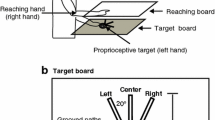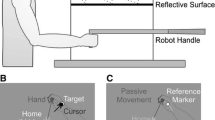Abstract
Ren et al. (J Neurophysiol 96:1464–1477, 2006) found that saccades to visual targets became less accurate when somatosensory information about hand location was added, suggesting that saccades rely mainly on vision. We conducted two kinematic experiments to examine whether or not reaching movements would also show such strong reliance on vision. In Experiment 1, subjects used their dominant right hand to perform reaches, with or without a delay, to an external visual target or to their own left fingertip positioned either by the experimenter or by the participant. Unlike saccades, reaches became more accurate and precise when proprioceptive information was available. In Experiment 2, subjects reached toward external or bodily targets with differing amounts of visual information. Proprioception improved performance only when vision was limited. These results indicate that the reaching system has a better internal model for limb positions than does the saccade system.








Similar content being viewed by others
References
Adamovich SV, Berkinblit MB, Fookson O, Poizner H (1998) Pointing in 3D space to remembered targets. I. Kinesthetic versus visual target presentation. J Neurophysiol 79:2833–2846
Batista AP, Santhanam G, Yu BM, Ryu SI, Afshar A, Shenoy KV (2007) Reference frames for reach planning in macaque dorsal premotor cortex. J Neurophysiol 98:966–983. doi:10.1152/jn.00421.2006
Brown LE, Rosenbaum DA, Sainburg RL (2003) Limb position drift: implications for control of posture and movement. J Neurophysiol 90:3105–3118. doi:10.1152/jn.00013.2003
Brown LE, Morrissey BF, Goodale MA (2008) Vision in the palm of your hand. Neuropsychologia. doi:10.1016/j.neuropsychologia.2008.11.021
Chapman CD, Heath MD, Westwood DA, Roy EA (2001) Memory for kinesthetically defined target location: evidence for manual asymmetries. Brain Cogn 46:62–66
Cohen YE, Andersen RA (2000) Reaches to sounds encoded in an eye-centered reference frame. Neuron 27:647–652
Culham JC, Gallivan J, Cavina-Pratesi C, Quinlan DJ (2008) fMRI investigations of reaching and ego space in human superior parieto-occipital cortex. In: Klatzky RL, Behrmann M, MacWhinney B (eds) Embodiment, Ego-space and Action. Psychology Press, New York, pp 247–274
Darling WG, Miller GF (1993) Transformations between visual and kinesthetic coordinate systems in reaches to remembered object locations and orientations. Exp Brain Res 93:534–547
Desmurget M, Rossetti Y, Jordan M, Meckler C, Prablanc C (1997) Viewing the hand prior to movement improves accuracy of pointing performed toward the unseen contralateral hand. Exp Brain Res 115:180–186
Desmurget M, Vindras P, Grea H, Viviani P, Grafton ST (2000) Proprioception does not quickly drift during visual occlusion. Exp Brain Res 134:363–377
Ernst MO, Banks MS (2002) Humans integrate visual and haptic information in a statistically optimal fashion. Nature 415:429–433. doi:10.1038/415429a
Ernst MO, Bulthoff HH (2004) Merging the senses into a robust percept. Trends Cogn Sci 8:162–169. doi:10.1016/j.tics.2004.02.002
Goodale MA, Westwood DA, Milner AD (2004) Two distinct modes of control for object-directed action. Prog Brain Res 144:131–144
Heath M, Westwood DA, Binsted G (2004) The control of memory-guided reaching movements in peripersonal space. Mot Control 8:76–106
Helms Tillery SI, Flanders M, Soechting JF (1991) A coordinate system for the synthesis of visual and kinesthetic information. J Neurosci 11:770
Lateiner JE, Sainburg RL (2003) Differential contributions of vision and proprioception to movement accuracy. Exp Brain Res 151:446–454. doi:10.1007/s00221-003-1503-8
Laufer Y, Hocherman S (1998) Visual and kinesthetic control of goal-directed movements to visually and kinesthetically presented targets. Percept Mot Skills 86:1375–1391
Marzocchi N, Breveglieri R, Galletti C, Fattori P (2008) Reaching activity in parietal area V6A of macaque: eye influence on arm activity or retinocentric coding of reaching movements? Eur J Neurosci 27:775–789. doi:10.1111/j.1460-9568.2008.06021.x
McGuire LM, Sabes PN (2009) Sensory transformations and the use of multiple reference frames for reach planning. Nat Neurosci 12:1056–1061. doi:10.1038/nn.2357
Messier J, Kalaska JF (1997) Differential effect of task conditions on errors of direction and extent of reaching movements. Exp Brain Res 115:469–478
Paillard J, Brouchon M (1968) Active and passive movements in the calibration of position sense. In: Freedman SJ (ed) The Neuropsychology of Spatially Oriented Behavior. Dorsey Press, Homewood III, pp 37–55
Paillard J, Brouchon M (1974) A proprioceptive contribution to the spatial encoding of position cues for ballistic movements. Brain Res 71:273–284
Pesaran B, Nelson MJ, Andersen RA (2006) Dorsal premotor neurons encode the relative position of the hand, eye, and goal during reach planning. Neuron 51:125–134. doi:10.1016/j.neuron.2006.05.025
Quinlan DJ, Culham JC (2007) fMRI reveals a preference for near viewing in the human parieto-occipital cortex. Neuroimage 36:167–187. doi:10.1016/j.neuroimage.2007.02.029
Ren L, Khan AZ, Blohm G, Henriques DY, Sergio LE, Crawford JD (2006) Proprioceptive guidance of saccades in eye-hand coordination. J Neurophysiol 96:1464–1477. doi:10.1152/jn.01012.2005
Rossetti Y (1998) Implicit short-lived motor representations of space in brain damaged and healthy subjects. Conscious Cogn 7:520–558. doi:10.1006/ccog.1998.0370
Sarlegna FR, Sainburg RL (2007) The effect of target modality on visual and proprioceptive contributions to the control of movement distance. Exp Brain Res 176:267–280. doi:10.1007/s00221-006-0613-5
Sarlegna FR, Sainburg RL (2009) The roles of vision and proprioception in the planning of reaching movements. Adv Exp Med Biol 629:317–335
Sober SJ, Sabes PN (2003) Multisensory integration during motor planning. J Neurosci 23:6982–6992
Sober SJ, Sabes PN (2005) Flexible strategies for sensory integration during motor planning. Nat Neurosci 8:490–497. doi:10.1038/nn1427
Soechting JF, Flanders M (1989) Sensorimotor representations for pointing to targets in three-dimensional space. J Neurophysiol 62:582–594
Tillery SI, Soechting JF, Ebner TJ (1996) Somatosensory cortical activity in relation to arm posture: nonuniform spatial tuning. J Neurophysiol 76:2423–2438
van Beers RJ, Sittig AC, Denier van der Gon JJ (1996) How humans combine simultaneous proprioceptive and visual position information. Exp Brain Res 111:253–261
van Beers RJ, Sittig AC, Denier van der Gon JJ JJ (1998) The precision of proprioceptive position sense. Exp Brain Res 122:367–377
van Beers RJ, Sittig AC, Gon JJ (1999) Integration of proprioceptive and visual position-information: An experimentally supported model. J Neurophysiol 81:1355–1364
Wann JP, Ibrahim SF (1992) Does limb proprioception drift? Exp Brain Res 91:162–166
Westwood DA, Goodale MA (2003) Perceptual illusion and the real-time control of action. Spat Vis 16:243–254
Westwood DA, Heath M, Roy EA (2001) The accuracy of reaching movements in brief delay conditions. Can J Exp Psychol 55:304–310
Acknowledgments
The authors thank John Kalaska, Yvonne Wong, Richard Lee and Giacomo Placenti for helpful discussions and Haitao Yang for technical support. This research was funded by an operating grant from the Natural Science and Engineering Research Council of Canada (Grant # 249877-02 RGPIN) to Jody C. Culham.
Author information
Authors and Affiliations
Corresponding author
Rights and permissions
About this article
Cite this article
Monaco, S., Króliczak, G., Quinlan, D.J. et al. Contribution of visual and proprioceptive information to the precision of reaching movements. Exp Brain Res 202, 15–32 (2010). https://doi.org/10.1007/s00221-009-2106-9
Received:
Accepted:
Published:
Issue Date:
DOI: https://doi.org/10.1007/s00221-009-2106-9




